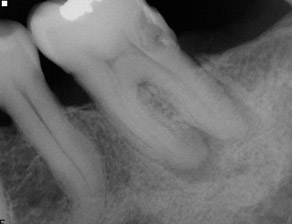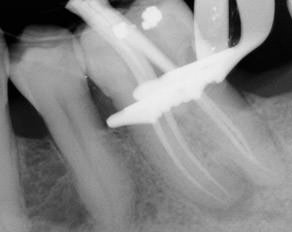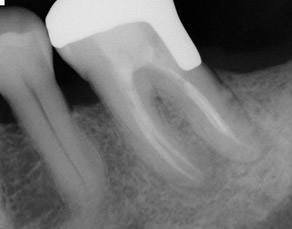This case highlights how even seemingly hopeless cases can be restored with simple endodontics done well. The molar tooth in question was the source of a painful infection and had been scheduled for extraction. Once the infection had settled however the patient decided they would rather not remove the tooth at this time and came to see me to see if there was any chance of hanging on to it. The patient’s dentist at the time of the acute infection had suggested that the tooth could not be treated and should be removed.
I think both dentists and patients can get tricked into thinking in terms simply of “save the tooth” or “take it out” and I believe this is misleading. You have to ask what do we mean by “save the tooth”. If we mean “save the tooth for the rest of the patient’s life” then if we were being honest with ourselves we would have to consider that a great many teeth are beyond “saving” and should come out now to avoid any further problems. In the past this approach was the mainstay of dentistry for many years and the “if in doubt, whip it out” mentality lead to patients loosing all of their teeth often at a very young age. Of course this was in a time when we did not have the equipment, knowledge or training that we have now but we are seeing a creeping return to the “take it out” approach where patients and dentists believe that implants are the best option. I am a huge fan of implants and at StoneRock we place more and more every year but I never see them as a coming with a lifetime guarantee. With this in mind I prefer to think not in terms of “saving a tooth” but more in terms of “delaying the loss of the tooth for as long as possible”. I know this does not sound like it comes with a the “hallallulla” moment that “saving a tooth” might but I think it allows us to have a much more pragmatic discussion about how we treat the tooth in question. I suscribe to a dynamic lifetime approach to treatment and view dentistry as a one way street down which we should all try to travel as slowly as possible.
On this occasion I was happy to restore the tooth with a root canal filing and a cast gold overlay and the 12 month review radiograph shows complete healing of the infection (dark shadow) around the tip of the root. At this stage the prognosis of the tooth is good and we can expect a good few more years out of it. If the infection returns or the tooth suffers further decay then it may well need to come out and at this stage and implant retained crown will be an ideal replacement option. If I have delayed this by 10 years, taking them perhaps from 6o years old to 70 years old then the implant retained crown does not have as long to last and may well become a “treatment for life” . I am hopeful also that in 10 years time implants will be even better than they are now so the patient will benefit from new improved treatments that are not currently available. I acknowledge that “if in doubt; try to delay the loss of the tooth for as long as possible with the least amount of dentistry” isn’t in any way as catchy as the previous rhyme but I do believe it is a much better way to start a treatment discussion.



If you are uncertain about how to proceed with treatment and would like advice please call the surgery on 01580 752202 and we will be happy to help.